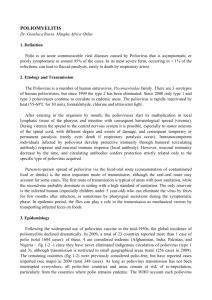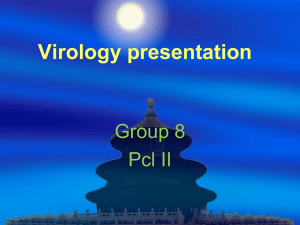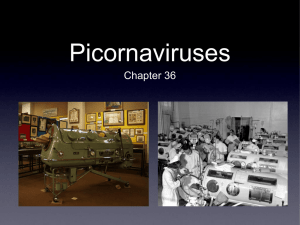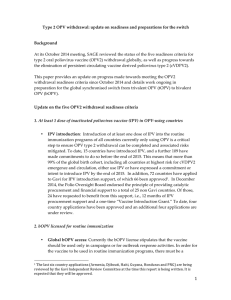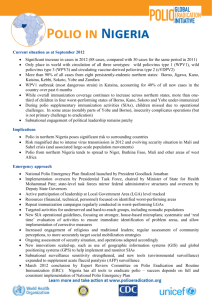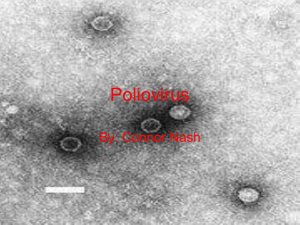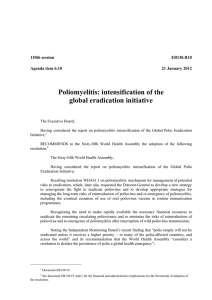ECDC TECHNICAL REPORT Introduction Surveillance
advertisement
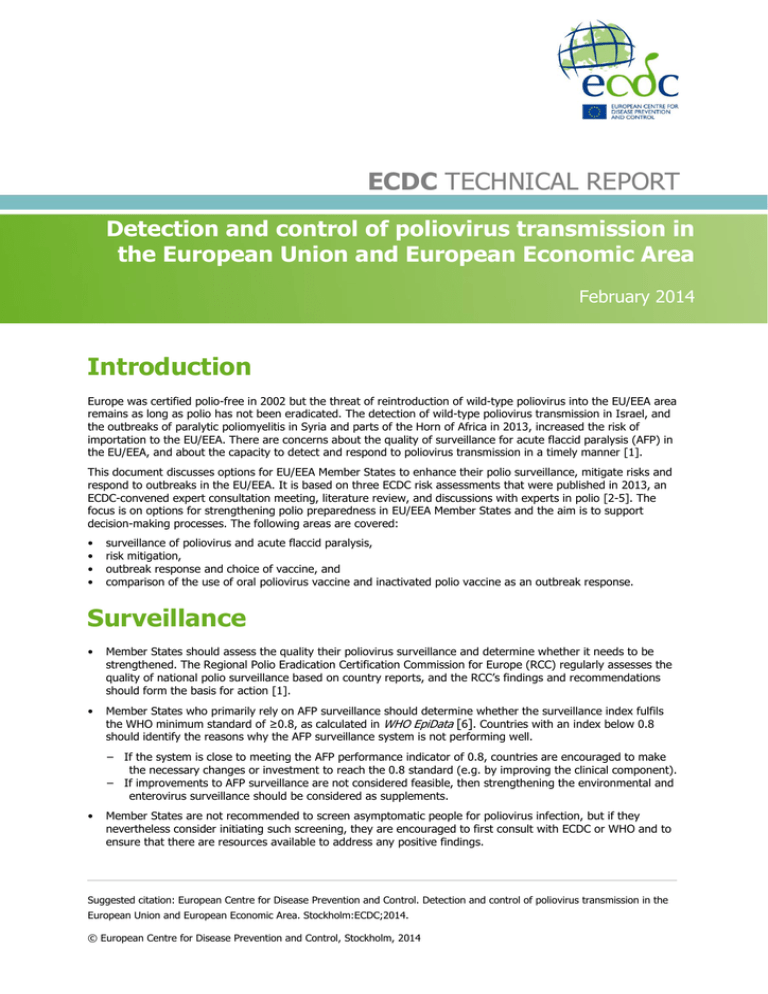
ECDC TECHNICAL REPORT Detection and control of poliovirus transmission in the European Union and European Economic Area February 2014 Introduction Europe was certified polio-free in 2002 but the threat of reintroduction of wild-type poliovirus into the EU/EEA area remains as long as polio has not been eradicated. The detection of wild-type poliovirus transmission in Israel, and the outbreaks of paralytic poliomyelitis in Syria and parts of the Horn of Africa in 2013, increased the risk of importation to the EU/EEA. There are concerns about the quality of surveillance for acute flaccid paralysis (AFP) in the EU/EEA, and about the capacity to detect and respond to poliovirus transmission in a timely manner [1]. This document discusses options for EU/EEA Member States to enhance their polio surveillance, mitigate risks and respond to outbreaks in the EU/EEA. It is based on three ECDC risk assessments that were published in 2013, an ECDC-convened expert consultation meeting, literature review, and discussions with experts in polio [2-5]. The focus is on options for strengthening polio preparedness in EU/EEA Member States and the aim is to support decision-making processes. The following areas are covered: • • • • surveillance of poliovirus and acute flaccid paralysis, risk mitigation, outbreak response and choice of vaccine, and comparison of the use of oral poliovirus vaccine and inactivated polio vaccine as an outbreak response. Surveillance • Member States should assess the quality their poliovirus surveillance and determine whether it needs to be strengthened. The Regional Polio Eradication Certification Commission for Europe (RCC) regularly assesses the quality of national polio surveillance based on country reports, and the RCC’s findings and recommendations should form the basis for action [1]. • Member States who primarily rely on AFP surveillance should determine whether the surveillance index fulfils the WHO minimum standard of ≥0.8, as calculated in WHO EpiData [6]. Countries with an index below 0.8 should identify the reasons why the AFP surveillance system is not performing well. − If the system is close to meeting the AFP performance indicator of 0.8, countries are encouraged to make the necessary changes or investment to reach the 0.8 standard (e.g. by improving the clinical component). − If improvements to AFP surveillance are not considered feasible, then strengthening the environmental and enterovirus surveillance should be considered as supplements. • Member States are not recommended to screen asymptomatic people for poliovirus infection, but if they nevertheless consider initiating such screening, they are encouraged to first consult with ECDC or WHO and to ensure that there are resources available to address any positive findings. Suggested citation: European Centre for Disease Prevention and Control. Detection and control of poliovirus transmission in the European Union and European Economic Area. Stockholm:ECDC;2014. © European Centre for Disease Prevention and Control, Stockholm, 2014 ECDC • Detection and control of poliovirus transmission Member States should take an active role to ensure that the healthcare workforce can appropriately identify and test possible cases of poliomyelitis. Risk mitigation • • • • Given that the consequences of poliovirus transmission will be most severe in unvaccinated individuals and that poliovirus transmission will be most effective in populations with low vaccination uptake, Member States should review their immunisation coverage and close immunity gaps in geographic areas and population groups with inadequate vaccination coverage. Member States should ensure that the vaccination status of refugees and migrants from polio-affected countries [7] is assessed at the time of entry into the EU/EEA area, and that people missing polio or other vaccines are offered vaccinations that are appropriate for their age and previous vaccination status (if known) as per the host country schedule. All refugees and migrants who are vaccinated in or before entry to the EU/EEA should have their vaccinations recorded on a personal vaccination card. If they do not have one, such a card should be provided to them, either the generic WHO ‘Yellow Card’ or the vaccination card used in the EU/EEA country where the individual is vaccinated. The vaccine provider should record vaccinations given to refugees and migrants in the national records. Member States should encourage their residents to be fully vaccinated against polio before traveling to polioinfected regions. Adults should have received at least one booster dose after the primary childhood series. Vaccines and outbreak response • • • A single case of poliovirus infection in a polio-free region is considered an outbreak and must be responded to quickly. Member States should test, and when necessary update, their national preparedness plans with support from ECDC and WHO. IPV has a role in polio outbreak control under certain circumstances, as demonstrated by the successful response to small outbreaks in Australia [8], the United States [9] and Sweden [10] (see Table, below, for overview of IPV and OPV). Circumstances under which vaccination with IPV could constitute an adequate vaccination response include those when contact tracing and environmental surveillance produce no evidence of widespread or sustained wild-type poliovirus (WPV) transmission. A typical scenario would be a single case of WPV infection in a person who has come directly from an area with polio circulation, or when transmission is limited to within a household that is part of a highly vaccinated community. Outbreak response vaccination with IPV is justified in the EU/EEA under the circumstances described above because the risk of WPV transmission within a given population is determined by the vaccination coverage and the standard of water and sanitation. In areas with good sanitation, such as the EU/EEA, oral–oral transmission of poliovirus may be more important than faecal–oral transmission. IPV induces similar immunity in the oropharynx as OPV and both OPV and IPV prevent paralytic disease and oral transmission. Although IPV induces weaker gut mucosal immunity than OPV, it does reduce the duration and concentration of faecal polio excretion, and this is likely to impact on transmission [11] [12]. Scientific evidence suggests that, in settings with high hygiene standards, IPV is able to prevent continued transmission from an outbreak. This was demonstrated during the 1992 polio outbreak in the Netherlands where it was shown that people vaccinated with IPV did not contribute to the circulation of the WPV (healthy IPV-vaccinated individuals were not found to excrete poliovirus) [13-15]. • Member States would be responsible for identifying and obtaining the necessary IPV to control an outbreak of WPV. • While the use of IPV for outbreak response means that the population will not be at risk of developing vaccineassociated paralytic poliomyelitis (VAPP) or from circulating vaccine-derived poliovirus, it is possible for nonparalytic WPV transmission to be sustained in a highly vaccinated population, as recently demonstrated in Israel. Thus, careful post-outbreak monitoring is necessary to ensure that there is no silent transmission of WPV occurring. • When there is evidence of sustained transmission (for example, multiple environmental sites positive for poliovirus; persistent environmental samples in a single site, even in the absence of disease; or multiple unrelated cases of disease) or when there is evidence of WPV transmission in a vaccine-naïve population, then monovalent or bivalent OPV is the vaccine of choice for controlling the outbreak and preventing paralytic disease. If OPV is not immediately available, IPV may be used to reduce the risk of paralytic disease. High coverage with doses of OPV may be needed to break the chain of transmission. • When OPV is used to respond to an outbreak, type-specific monovalent OPV (mOPV) should be the first choice 2 ECDC Detection and control of poliovirus transmission for outbreak response. The next best choice is bivalent OPV (bOPV), followed by trivalent OPV (tOPV) if no other OPV is available or cannot be used due to regulatory constraints. • OPV is not in routine use in the EU/EEA, with the exception of Poland. It is only licensed in those EU/EEA countries where it is produced for export (Belgium, France and Italy), and in Bulgaria and Poland where trivalent OPV is licensed. Lack of marketing authorisation in many countries limits accessibility to OPV unless regulatory provisions are made for emergency use. Countries need to take early action regarding licensing to ensure availability of OPV before they are faced with poliovirus introduction, and possible public resistance to an unauthorised product used under emergency provisions. The European Medicines Agency has a pivotal role in facilitating licensing options for OPV for those Member States currently with no licensed OPV product. • Should an outbreak occur, all EU/EEA Member States will have access to the global OPV stockpile managed by WHO and UNICEF for emergency use; OPV stockpiling for emergency use in the EU/EEA is not encouraged because of limited supply and shelf-life. • If OPV is used, communication messages should clarify that there is virtually no risk of VAPP from OPV use in persons previously vaccinated with IPV. Campaign messaging should be that OPV use is necessary to provide mucosal immunity, reduce virus shedding, and stop transmission. • If OPV is used for outbreak control, individuals with known allergy to vaccine components and those with immunosuppression, and their household contacts, should receive IPV and not OPV. Table. Advantages and disadvantages of OPV versus IPV for outbreak response in EU/EEA Attribute Vaccine-associated paralytic poliomyelitis Emergence of circulating vaccinederived poliovirus OPV IPV Rare None Yes No Other serious adverse events None known Use in immunocompromised/family Systemic immunity Mucosal immunity Secondary transmission of vaccine virus Prevent paralytic disease Prevent transmission Public acceptance Regulatory approval in EU/EEA No High High Possible provocation paralysis in patient incubating polio at time of injection Yes High Lower in the intestinal tract Yes No Yes Yes Possibly reduced Approved in a few Member States Stockpile availability Yes (UNICEF) Current cost Low Use in outbreaks All outbreaks Yes Possibly reduced Potentially higher Approved in all Member States Some Member States have stockpiles Higher Outbreaks with limited cases/transmission IPV: inactivated poliovirus vaccine, OPV: oral poliovirus vaccine. 3 ECDC Detection and control of poliovirus transmission References 1. World Health Organization. Report of the 27th Meeting of the European Regional Certification Commission for Poliomyelitis Eradication: Copenhagen, Denmark 30–31 May, 2013: WHO Regional Office for Europe; 2013. Available from: http://www.euro.who.int/__data/assets/pdf_file/0016/200752/Report-of-the-27thMeeting-of-the-European-Regional-Certification-Commission-for-Poliomyelitis-Eradication.pdf. 2. European Centre for Disease Prevention and Control. Rapid risk assessment: Suspected outbreak of poliomyelitis in Syria: Risk of importation and spread of poliovirus in the EU. Stockholm: ECDC; 2013 [cited 24 February 2014]. Available from: http://ecdc.europa.eu/en/publications/Publications/RRA%20poliomyelitis%20Syria%2021%2010%202013.pdf. 3. European Centre for Disease Prevention and Control. Risk Assessment: Wild-type poliovirus 1 transmission in Israel – what is the risk to the EU/EEA? Stockholm: ECDC; 2013 [cited 24 February 2014]. Available from: http://ecdc.europa.eu/en/publications/Publications/polio-risk-assessment-transmission-in-Israel.pdf. 4. European Centre for Disease Prevention and Control. Risk of introduction and transmission of wild-type poliovirus in EU/EEA countries following events in Israel and Syria – updated risk assessment, December 2013: ECDC; 2013 [cited 24 February 2014]. Available from: http://ecdc.europa.eu/en/publications/Publications/poliomyelitis-risk-assessment-update-10-December2013.pdf. 5. European Centre for Disease Prevention and Control. Expert consultation on scientific evidence linked to polio virus in Israel and Syria, Stockholm, 5 November 2013: ECDC; 2013 [cited 24 February 2014]. Available from: http://www.ecdc.europa.eu/en/publications/Publications/Expert%20consultation%20mtg%20report%20%20polio%20Israel%20Syria%20-%20final.pdf. 6. World Health Organization. WHO EpiData. WHO. Published monthly [cited 24 February 2014]. Available from: http://www.euro.who.int/en/health-topics/communicable-diseases/measles-andrubella/publications/who-epibrief-and-who-epidata. 7. Global Polio Eradication Initiative. Polio this week: GPEI; 2014. Available from: http://www.polioeradication.org/Dataandmonitoring/Poliothisweek.aspx 8. Carnie JA LR, Moran R, Brown L, Meagher J, Roberts JA, Thorlry, BR. Public health response to imported case of poliomyelitis, Australia 2007. Emerg Infect Dis [Internet]. Nov 2009 [cited 20 February 2014]. Available from: http://wwwnc.cdc.gov/eid/article/15/11/09-0027.htm. 9. Alexander JP, Ehresmann K, Seward J, Wax G, Harriman K, Fuller S, et al. Transmission of imported vaccine-derived poliovirus in an undervaccinated community in Minnesota. The Journal of infectious diseases. 2009;199(3):391-7. 10. Bottiger M, Mellin P, Romanus V, Soderstrom H, Wesslen T, von Zeipel G. Epidemiological events surrounding a paralytic case of poliomyelitis in Sweden. Bulletin of the World Health Organization. 1979;57(1):99-103. 11. Hird TR, Grassly NC. Systematic review of mucosal immunity induced by oral and inactivated poliovirus vaccines against virus shedding following oral poliovirus challenge. PLoS Pathogens. 2012;8(4):e1002599. 12. Duintjer Tebbens RJ, Pallansch MA, Chumakov KM, Halsey NA, Hovi T, Minor PD, et al. Review and assessment of poliovirus immunity and transmission: synthesis of knowledge gaps and identification of research needs. Risk analysis: an official publication of the Society for Risk Analysis. 2013;33(4):606-46. 13. Conyn-van Spaendonck MA, Oostvogel PM, van Loon AM, van Wijngaarden JK, Kromhout D. Circulation of poliovirus during the poliomyelitis outbreak in The Netherlands in 1992-1993. American journal of epidemiology. 1996;143(9):929-35. 14. Oostvogel PM, van Wijngaarden JK, van der Avoort HG, Mulders MN, Conyn-van Spaendonck MA, Rumke HC, et al. Poliomyelitis outbreak in an unvaccinated community in The Netherlands, 1992-93. Lancet. 1994;344(8923):665-70. 15. van der Avoort HG, Reimerink JH, Ras A, Mulders MN, van Loon AM. Isolation of epidemic poliovirus from sewage during the 1992-3 type 3 outbreak in The Netherlands. Epidemiology and infection. 1995;114(3):481-91. 4

